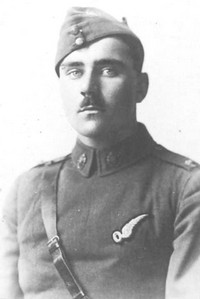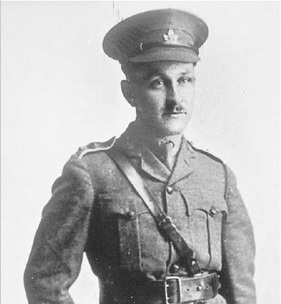Today saw one of the busiest days of action on the Western Front.
This morning, 43 Squadron RFC in their Sopwith Strutters were on a reconnaissance mission escorted by FE8s from 40 Squadron RFC. Jasta 11 scrambled to intercept them. The combat showed that a strong formation could protect against the superior German fighters.

Edwin Louis Benbow
In the ensuing fight 40 Squadron’s Captain Robert Gregory in FE8 6384, and Lieutenant Edwin Louis Benbow in FE8 A4871, claimed to have shot down an Albatross Scout Albatros Scout in flames. Captain Harold Harrington Balfour and 2nd Lieutenant Arthur Roberts in Sopwith Strutter A1097 and 2nd Lieutenant Charles Price Thornton and Lieutenant Harry Dudley Blackburn, in another Sopwith Strutter also claimed to have shot down enemy scouts.
In the event, Manfred Von Richthofen had his engine and fuel tanks shot through and made a forced landing behind the lines. His colleague Leutnant Hans-Georg Eduard Lübbert was also shot down. He was wounded but made a successful landing behind his own lines. Von Richthofen attempted to claim that on of the Sopwith Strutters hit him, but contemporary accounts suggest it is more likely that one of the FE8s hit him most likely Benbow. Presumably, the fact of him being shot down by another fighter was to much for Von Richthofen or the propaganda machine.

Geoffrey Brichta
43 Squadron did not get away scot-free as 2nd Lieutenant Stanley James Pepler and Captain James Duff Stuart were shot down in flames and killed in their Sopwith Strutter (A978) by Leutnant Karl Schaeffer.

Gerald Gosset-Bibby
Von Richthofen describes in his book that the officer who picked him up had no idea who he was and only realised in the mess hall when he came in wearing his Pour Le Merite. At that point he “feasted me with oysters and champagne”.

George Milne Underwood
Von Richthofen was back in the air in the afternoon where his patrol encountered 16 Squadron RFC. He shot down and killed 2nd Lieutenant Gerald Maurice Gosset-Bibby and Lieutenant Geoffrey Joseph Ogilvy Brichta in their BE2e (A2785).
Earlier in the day, his colleague Leutnant Kurt Wolff had claimed his first victory over another 16 Squadron aircraft when he shot down 2nd Lieutenant Albert Edward Watts and 2nd Lieutenant George Milne Underwood in their BE2d 5856. Both were killed in the crash.
It was a bad day for the RFC as another 6 crew were killed and 6 taken prisoner.

Evelyn Paget Graves
Jasta 1 came of better in a fight with 60 Squadron RFC as 2nd Lieutenant Philip Solomon Joyce was shot down in his Nieuport 16 (A208) by Obleutnant Hans Kummetz and Major Evelyn Paget Graves was brought down in flames in his Nieuport 17 (A213) by Walter Cymera.
Jasta 2 shot down two aircraft from 57 Squadron RFC and took both crews prisoner. They were Lieutenant Francis Eric Hills and 2nd Lieutenant Alfred Gordan Ryall in FE2d A1948 and Captain William Swanson Read Bloomfield and 2nd Lieutenant Victor Oswald Lonsdale in FE2d A1953.
Their colleagues Lieutenant William Frederick Waller Hills and 2nd Lieutenant William Sutton Gardner in FE2d A1963 were less lucky as they suffered a broken propeller following an attack by Vitzfeldwebel Heinrich Büssing from Jasta 5. They crashed and were killed.
Lieutenant Cuthbert William Short MC and Lieutenant Simon MacKay Fraser of 3 Squadron wre4 shot down in their Morane P (A268). Short managed to land in friendly territory but later died of his wounds. Edmund Nathanael from Jasta 5 claimed the victory.

Denys Greenhow
Captain John Ewart MacKay and 2nd Lieutenant Denys Edward Greenhow from 45 Squadron were attacked by 5 enemy aircraft and shot down in their Sopwith Strutter A1072. MacKay was able to land the aircraft but Greenhow had been killed. Both Karl Schaeffer from Jasta 11 and R Kralewski from Jasta 4 claimed victory.
Later in the afternoon Jasta 2 encountered 32 Squadron RFC another 2 aircraft were shot down and the crews taken prisoner.They were Lieutenant Maximilian John Jules Gabriel Mare-Montembault MC in DH2 7882 shot down by Oberleutnant Adolf Ritter von Tutschek and Captain Herbert Gordon Southon in DH2 7941 shot down by Leutnant Werner Voss.



 In the end there were only two fatalities during the day when observer Lieutenant Harold George Collins from 48 Squadron was killed on patrol. His pilot Lieutenant John Herbert Towne Letts got their Bristol F2B (A3315) back. They also claimed to have shot down two Albatrosses. Also Lieutenant Johannes Hieronymus Brink from 4 Squadron was wounded and later died when he and his observer Lieutenant Robert Ellis Heath (who was wounded) were shot down and crashed in their BE2d 5742 This has traditionally been allocated to Leutnant Karl Schaeffer from Jasta 11 but this seems unlikely as he was serving on a different part of the front at the time.
In the end there were only two fatalities during the day when observer Lieutenant Harold George Collins from 48 Squadron was killed on patrol. His pilot Lieutenant John Herbert Towne Letts got their Bristol F2B (A3315) back. They also claimed to have shot down two Albatrosses. Also Lieutenant Johannes Hieronymus Brink from 4 Squadron was wounded and later died when he and his observer Lieutenant Robert Ellis Heath (who was wounded) were shot down and crashed in their BE2d 5742 This has traditionally been allocated to Leutnant Karl Schaeffer from Jasta 11 but this seems unlikely as he was serving on a different part of the front at the time.











